Sweet Corn
Low numbers of European corn borer (ECB) moths have been captured in parts of the state. Overall, this flight has been weak, but consistently warmer weather may result in somewhat higher numbers over the next week. The highest adult activity is currently in Burlington and Gloucester counties, although even there it is low. Whorl corn is the primary target for egg laying, and injury as high as 4% of plants infested has been found in northern Burlington County this week. Feeding levels could be somewhat higher in the southern counties, and should rise over the next 3 weeks.
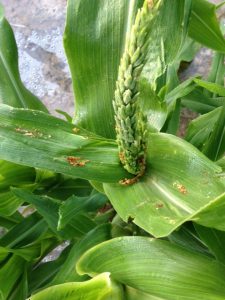 Look for the characteristic “shot-hole” type of feeding (photo below at right) and consider treating when infested plants exceed 12% in a 50 plant sample. As plantings proceed to the pre-tassel stage, ECB larvae may be found in emerging tassels (see photo at left). It is a good idea to treat individual plantings as they move into the full tassel/first silk stage one time. This eliminates any ECB larvae that have emerged with the tassels as they begin to move down the stalk to re-enter near developing ears.
Look for the characteristic “shot-hole” type of feeding (photo below at right) and consider treating when infested plants exceed 12% in a 50 plant sample. As plantings proceed to the pre-tassel stage, ECB larvae may be found in emerging tassels (see photo at left). It is a good idea to treat individual plantings as they move into the full tassel/first silk stage one time. This eliminates any ECB larvae that have emerged with the tassels as they begin to move down the stalk to re-enter near developing ears.
Useful insecticides for this particular application include synthetic 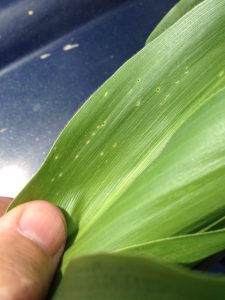 pyrethroids (IRAC Grp 3), spinosyns (including OMRI approved Entrust) IRAC Grp 5), and diamides such as Coragen or Vantacor (IRAC Grp 28) or materials such as Besiege which include the active ingredient in Coragen. Synthetic pyrethroids alone should NOT be used for corn earworm (CEW) protection on silking corn. Control with these materials is very inconsistent.
pyrethroids (IRAC Grp 3), spinosyns (including OMRI approved Entrust) IRAC Grp 5), and diamides such as Coragen or Vantacor (IRAC Grp 28) or materials such as Besiege which include the active ingredient in Coragen. Synthetic pyrethroids alone should NOT be used for corn earworm (CEW) protection on silking corn. Control with these materials is very inconsistent.
The highest nightly trap catches of ECB for the week ending 5/31/22 are as follows:
| Downer 2 | Cinnaminson 1 | Hillsborough 1 |
| Milltown 2 | Clinton 1 | Jones Island 1 |
| Pedricktown 2 | Crosswicks 1 | Medford 1 |
| Bellemeade 1 | Georgetown 1 | Woodstown 1 |
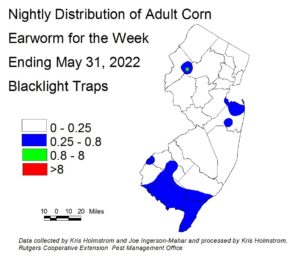 Corn earworm (CEW) moths continue to be captured in blacklight traps from many parts of the state this past week (see map at left), although numbers are very low. While the pheromone trap network is not fully deployed at this time, traps that are active are also getting low levels of moths (see map below at left). There is little risk from this pest currently, as the earliest plantings are not yet in silk. Be sure to access information from this publication in the upcoming weeks to determine how frequently you must treat silking sweet corn to protect it from CEW infestation.
Corn earworm (CEW) moths continue to be captured in blacklight traps from many parts of the state this past week (see map at left), although numbers are very low. While the pheromone trap network is not fully deployed at this time, traps that are active are also getting low levels of moths (see map below at left). There is little risk from this pest currently, as the earliest plantings are not yet in silk. Be sure to access information from this publication in the upcoming weeks to determine how frequently you must treat silking sweet corn to protect it from CEW infestation.
The highest nightly blacklight trap catches of CEW for the week ending 5/31/22 are as follows:
| Centerton 1 | Elm 1 | Matawan 1 |
| Crosswicks 1 | Farmingdale 1 | Georgetown 1 |
| Downer 1 | Hackettstown 1 | Green Creek 1 |
| Eldora 1 | Jones Island 1 | Pedricktown 1 |
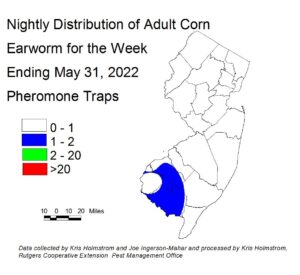 The highest nightly pheromone trap catches of CEW for the week ending 5/31/22 are as follows:
The highest nightly pheromone trap catches of CEW for the week ending 5/31/22 are as follows:
| Woodstown 4 | Dayton 1 | Georgetown 1 | Oldwick 1 |
| Allamuchy 1 | Farmingdale 1 | Matawan 1 |
Cole Crops
Low numbers of imported cabbage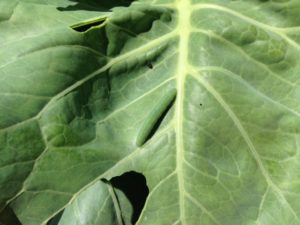 worm (ICW at left) continue in cole crop plantings everywhere. With warmer temperatures on the way, these infestations should increase rapidly and continue for the duration of the growing season. Check 5 consecutive plants each in 10 random locations throughout the planting, paying particular attention to the innermost leaves where ICW often feed (see photo at lower right). Consider treating if caterpillars are found on 10% or more plants that are in the 0-9 true leaf stage. From 9-leaf to the early head stage (in broccoli, cauliflower, and cabbage) infestations up to 20% may be tolerated. Once heads begin to form, a 5% threshold should be observed to protect the marketable portion of
worm (ICW at left) continue in cole crop plantings everywhere. With warmer temperatures on the way, these infestations should increase rapidly and continue for the duration of the growing season. Check 5 consecutive plants each in 10 random locations throughout the planting, paying particular attention to the innermost leaves where ICW often feed (see photo at lower right). Consider treating if caterpillars are found on 10% or more plants that are in the 0-9 true leaf stage. From 9-leaf to the early head stage (in broccoli, cauliflower, and cabbage) infestations up to 20% may be tolerated. Once heads begin to form, a 5% threshold should be observed to protect the marketable portion of 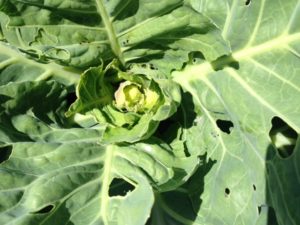 the plant. For leafy greens such as collards and kale, 10% plants infested is the threshold throughout.
the plant. For leafy greens such as collards and kale, 10% plants infested is the threshold throughout.
Diamondback moth larvae (DBM) are becoming the dominant pest in a number of scouted plantings. Remember that some populations of DBM are resistant to carbamate and synthetic pyrethroid insecticides. The lack of DBM control with these insecticides has been noted in NJ previously. It is important to distinguish between common cole crop pests for this reason. DBM larvae grow to a length of approximately 0.5”, and taper toward both ends (see photo at lower right).  These caterpillars thrash violently when disturbed. ICW grow to a length of approximately 1.25” and are covered with short hairs. Some chemistries that specifically target caterpillar pests are effective against DBM as well as all other caterpillar pests of cole crops. These materials include (active ingredient – trade name (IRAC* code)):
These caterpillars thrash violently when disturbed. ICW grow to a length of approximately 1.25” and are covered with short hairs. Some chemistries that specifically target caterpillar pests are effective against DBM as well as all other caterpillar pests of cole crops. These materials include (active ingredient – trade name (IRAC* code)):
Spinosad/Spinetoram – Entrust/ Radiant (5)
Chlorantraniliprole – Coragen (28)
Cyantraniliprole – Exirel (28)
The IRAC group 5 insecticide, Entrust, is OMRI approved for organic production. Insecticides based on the soil-inhabiting bacterium Bacilllus thuringiensis (B.t.) may also be effective on caterpillar pests of cole crops. Examples include Xentari and Javelin. It is important to return to treated fields within 24-48 hours to assess the DBM control. If significant numbers of larvae remain, it is an indication that your population may be resistant to the material most recently used.
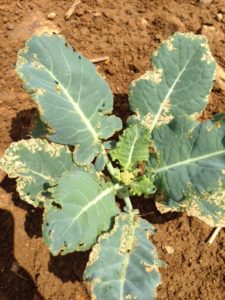 Flea beetles remain very active in a number of plantings, and warmer days will accelerate injury. Signs of “shot-hole” in leaves of host crops are an indication that flea beetles are present, even if the pests are not visible due to cold/wet weather. These pests have a preference for the “hotter” flavored crops like arugula, mustard greens, and turnip greens. They also attack Tuscan or lacinato kale frequently. Plants may be protected with at-planting, soil-applied neo-nicotinoid insecticides (see the 2020/21 Commercial Vegetable Production Recommendations for products). An OMRI approved foliar material for flea beetle management is Pyganic. This product will provide knock-down of flea beetles, but may need to be applied frequently on preferred host crops.
Flea beetles remain very active in a number of plantings, and warmer days will accelerate injury. Signs of “shot-hole” in leaves of host crops are an indication that flea beetles are present, even if the pests are not visible due to cold/wet weather. These pests have a preference for the “hotter” flavored crops like arugula, mustard greens, and turnip greens. They also attack Tuscan or lacinato kale frequently. Plants may be protected with at-planting, soil-applied neo-nicotinoid insecticides (see the 2020/21 Commercial Vegetable Production Recommendations for products). An OMRI approved foliar material for flea beetle management is Pyganic. This product will provide knock-down of flea beetles, but may need to be applied frequently on preferred host crops.
Peppers
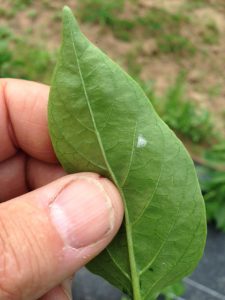 With ECB moth activity now present, growers should be looking for ECB egg masses (see photo at left) on the underside of pepper leaves. The larvae that hatch from these eggs will bore into the central stem of pepper plants in the absence of suitable fruit. This damage causes the tops of the plant to die, and eliminating the crown set of fruit in the process. Check 2 leaves per plant on 5 consecutive plants in 10 random locations. Consider treating if 2 or more leaves are found to have ECB larvae on the lower surface.
With ECB moth activity now present, growers should be looking for ECB egg masses (see photo at left) on the underside of pepper leaves. The larvae that hatch from these eggs will bore into the central stem of pepper plants in the absence of suitable fruit. This damage causes the tops of the plant to die, and eliminating the crown set of fruit in the process. Check 2 leaves per plant on 5 consecutive plants in 10 random locations. Consider treating if 2 or more leaves are found to have ECB larvae on the lower surface.
Pepper weevil
Weevil traps are being deployed now. No weevils have been trapped as yet.
A fact sheet is available for anyone interested in monitoring for pepper weevils on their own: FS1330: Monitoring and Management of Pepper Weevil in New Jersey (Rutgers NJAES).

